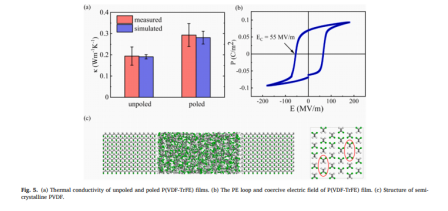On January 07, 2021, Nano Energy published a research article online entitled “Electric-field-induced modulation of thermal conductivity in poly (vinylidene fluoride)” as co-researched by Prof. Yang Nuo's project team of the School of Energy and Power Engineering (EPE) and Associate Prof. Zhang Guangzu's project team of the School of Optical and Electronic Information of Huazhong University of Science and Technology (HUST).
Regulating the thermal conductivity of materials is of great significance to micro-nanoelectronic devices, optoelectronic devices, batteries, aerospace, and energy utilization. In recent years, scientists both at home and abroad have proposed many novel methods in modulating thermal conductivity, such as the use of nanostructures, mechanical stretching and doping. Although the strategies mentioned above are markedly effective, the processes are relatively complicated and tend to affect other properties of materials, with their scope of application limited as a result.
Prof. Yang's study proposes a new way, the electric-field-induced modulation to the thermal conductivity in poly by changing the atomic structure of PVDF. In recent years, an array of research reports have been heard on electric-field-induced modulation to the optical, electrical, and magnetic properties of materials under control, which is characterized by a fast response, low energy consumption, in-situ and flexible modulation. However, the way is still in its infancy in terms of thermal performance modulation; instead, the electric field-induced modulation to thermal conductivity will be of broader prospects in application.

The electric field-induced modulation to the thermal conductivity in ferroelectric in poly (vinylidene fluoride) is introduced here. First, it is found through molecular dynamics simulation that the thermal conductivity of the PVDF array with quasi-crystalline structure increases in all three directions under electric polarization, especially along the electric field direction with an increased ratio up to 3.25 times. Secondly, experimental measurement and simulation of PVDF film of semi-crystalline structure, show that the thermal conductivity increases by 1.5 times after polarization. The above results serve to verify the effect of the newly proposed way of thermal conductivity modulation.
The morphological analysis of the atomic chain structure shows that electric polarization can enhance the orderliness, compactness, and inter-chain restraint of PVDF molecular chains. Through the analysis of the phonon spectral density, it is found that the above-mentioned morphological change functions reduce the phonon anharmonicity, suppress the phonon scattering, and increase the phonon group velocity, thereby increasing the thermal conductivity of PVDF. Theoretical analysis shows that the modulation effect can be further boosted by improving the crystallinity of the samples and the orderliness of molecular chain arrangement.
The modulation strategy proposed in this study is widely applicable to ferroelectric materials. In addition, the two different thermal conductivity states before and after polarization are also of potential applications in thermal intelligence fields such as thermal energy storage (TES) and thermal switching devices.
Prof. Yang Nuo of the School of Energy and Power Engineering and Associate Prof. Zhang Guangzu of the School of Optical and Electronic Information are the corresponding authors of the article. Dr. Deng Shichen and postgraduate Yuan Jiale of EPE, and postgraduate Lin Yuli of the School of Optical and Electronic Information are the co-first authors, and Dr. Yu Xiaoxiang, Dr. Ma Dengke, Huang Yuwen and Ji Rencai have also made contributions to the study.
This research has been supported by the National Key R&D Program of China and funded by the National Natural Science Foundation of China.
Paper Link: https://doi.org/10.1016/j.nanoen.2021.105749




